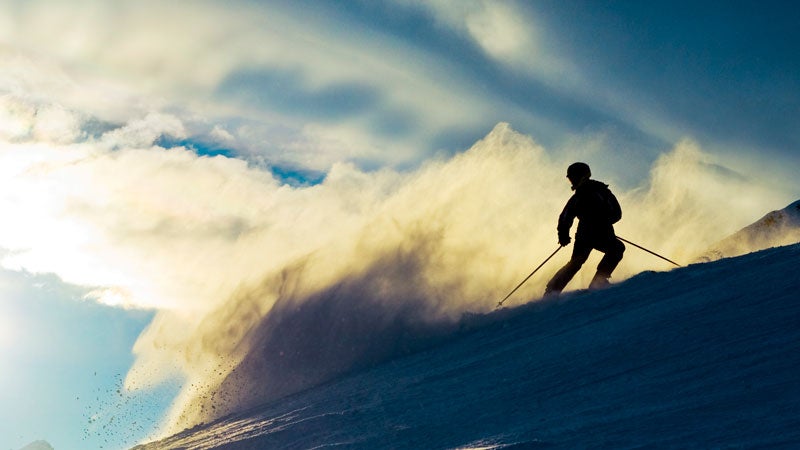When you watch a ski movie, the stars carve buttery turns down an Alaskan precipice, whip through moguls without a pause, and jump cliffbands in a powdery poof, schussing away without a second thought.
But—just like you—even the experts have room for improvement. We asked some of America’s best skiers and instructors for tips on technique and having fun—at any level.
STEEPS
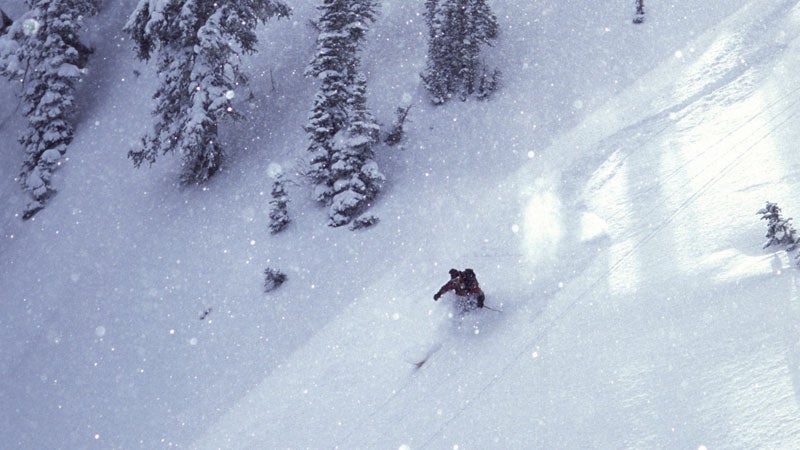
“When you start getting into mid and high alpine terrain, whether it’s low angle or steep, pick out lines that don’t have objective hazards, and choose the correct terrain for your ability,” says , big mountain skier and guide.
Beginner: The scale of the landscape and the severity of the slope can freak you out. Project with your eyes, look ahead. Keep your hands up in front of you as you’re carving. If you can’t see your hands, they’re not far enough in front of you. Don’t look at your ski tips, look ahead for your second or third turn. ��Stop looking at all the steep stuff around you that’s beyond your ability, focus on a line you can manage.
Intermediate: Widen your stance, lower your body position and your center of gravity by bending your knees and keeping your back straight. Project with your eyes, looking in front of you for your third or fourth turn. Regardless of how wide your skis are, engage your edges—don’t wash your tails out and mush through your turns. Carve, don’t slarve. Keep your hands out like they’re on the ends of the arms of a recliner chair. Don’t drag your pole basket—no ruddering. Ruddering makes your hips fall behind your skis. Nothing should be behind you in skiing—all the action is out front. Any movement behind you is working against you.
Advanced: Line selection is the most important skill for an advanced skier. The best skiers look at the terrain three dimensionally. Don’t fight gravity. Take advantage of double fall lines. If a line drops left, turning right into the hill will let you scrub speed without fighting gravity. Coming off a steeper pitch, look at your run out and factor that into your line selection. Keep your upper body quiet.
POWDER
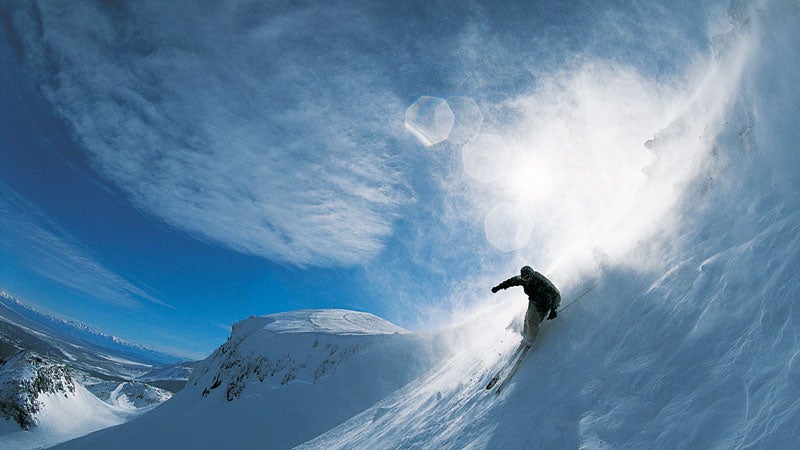
“Skiing powder is one of the greatest joys on being on snow,” says , PSIA ski instructor and training manager for the Aspen/Snowmass Ski and Snowboard School. Here’s how to make the most of it:
Beginner: One of the biggest misconceptions about powder is that you have to lean back to get your skis out of the snow.��A ski is designed to float.��Stand in the middle of the ski, tense your core and glutes, and enjoy the ride. On groomers, skidding and shaping the turn is how we control speed. In powder, the snow will slow you down.��A straighter line and more speed will help you turn.
Intermediate: On groomers you put more pressure on your downhill ski. In powder, you stand evenly on both feet.��This will make your skis float evenly giving you a smoother ride. Keep turning! When you finish one turn go straight into the next. It may sound tiring, but linking the turns together will create rhythm and flow and lead to that sought after effortless feeling of surfing in the snow.
Advanced: Make thinner turns.��Even on steep terrain, deep snow will slow you down.��Blend the finish of one turn into the start of the next—it’ll help you stay afloat and moving through the snow. Tip your skis onto edge and you’ll be amazed how well they arc and power through soft snow.��Weight your heels not the balls of your feet—this will get your tips up and let you surf. And, choose fat skis for powder, 100 mm or wider in the waist and not too stiff with plenty of rocker or early rise.�� Rent if you’re not sure you want to buy.
TREES
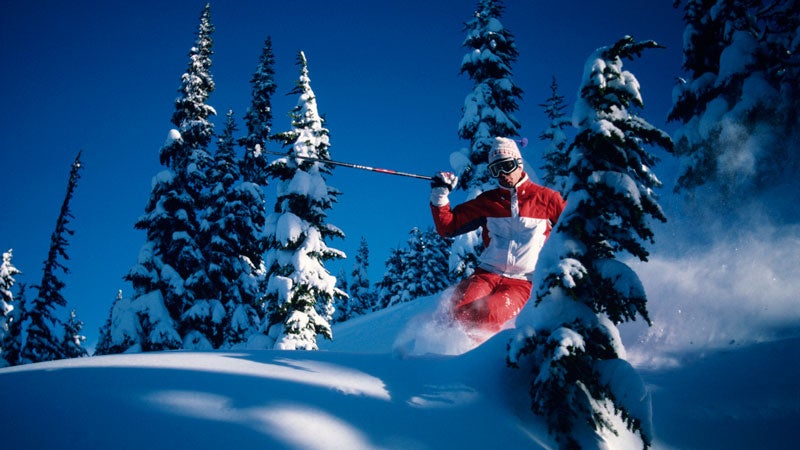
“During or after a storm, trees may hide the mountain’s best snow,” says , big mountain skier and co-founder of SheJumps.org. Here are her tips for ripping the trees:
Beginner: Trees intimidate most people because they’re afraid they’re going to hit them. You go where you look. So don’t look at the trees, look through them. Control your speed, then schmear your turn. Avoid skiing too close to trees—tree wells are one of the most forgotten hazards of tree skiing. And always ski with a partner so that you can help each other if one of you gets into trouble. Don’t wear loose clothes—they can get caught.
Intermediate: When you’re in the trees, you’re probably skiing powder. Lean back on your skis, but assume an agile stance with bent knees that will let you maneuver quickly. Get into a rhythm—springing like a deer around the trees. Spring, don’t slog. Set a hard edge above a tree, and making that tree a gate to get around it.
Advanced: The ability to react quickly is a key to enjoying tree skiing safely.��Keeping a strong core, glutes, and chest, will give your body stability allowing your feet to move quickly to avoid wooded obstacles.
A strong pole plant will give your feet and legs something to turn against, which will quicken your reaction time in tight trees. Look two turns ahead, look for open spaces to carve through. And if you have the choice, ski a reverse camber ski. It’s ideal for the woods—it’ll let you make playful turns at a slower speeds.
BUMPS
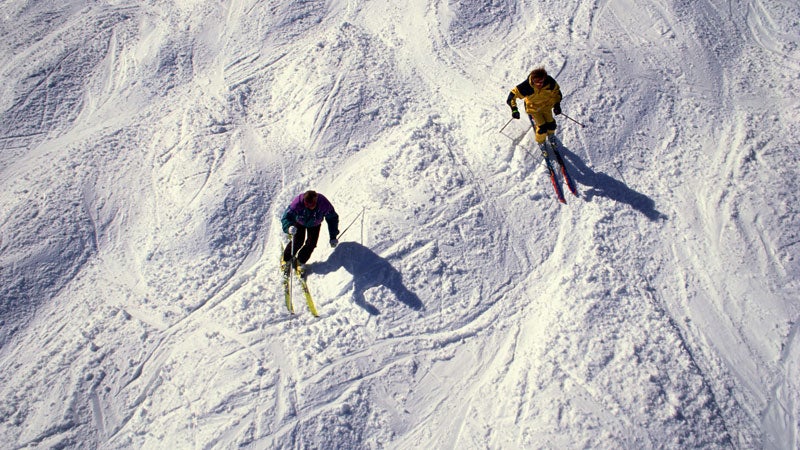
“There is nothing on the hill that challenges your legs and your technique more than moguls,” says Mike Hattrup, former mogul specialist for the US Freestyle Ski Team and current Global Director for K2’s ���ϳԹ��� Category. Here’s how to find you line:
Beginner: Turn on the tops of the bumps. Plant your pole at the bump’s highest point, and initiate your turn. At the peak of a bump, there is little tip and tail pressure so your ski skids around easy. Make your turn, and from your traverse, pick the next mogul that looks round, gradually sloped and inviting, and repeat.�� Traverse through the troughs, but don’t ski from trough to trough. Ski from the trough to the top of the next bump, and repeat. Always look one to two turns ahead, and skid your skis around the mogul as you move forward.
Intermediate: Skis are convex, or slightly downward curved. When you’re on top of a bump, the shape of your ski matches the shape of the bump, which makes it easy to pivot and skid the skis around. And on top of a bump, your tips and tails are likely in the air, so the effective length of you ski is shorter, which makes it easier to turn.��Ski from the tops of the moguls, but link your turn quickly by separating the movement of your upper and lower body. Even if your skis are going across the hill, keep your body facing downhill. It will make your next turn easier because your body wants to uncoil, straighten out and bring your skis around—your next turn will want to come quick. Don’t be too picky as to which mogul you’re turning on. Keep your upper body relaxed, your ankles and knees soft. Let the moguls push up on your ankles and knees to smooth out your run. If you don’t keep your ankles soft, you’ll fall back into the toilet and lose control. Look two to three turns ahead. Tighten your turn radius, so your turns are quicker, not traversing.
Advanced: Looking three to five turns down the fall line. Use the airplane turn to smooth out your line. Skiing angled slightly across the hill use the front side of a mogul as your launch pad, and spring or let yourself be lifted by the bump and your speed off the snow so that you land on the downhill side of the next mogul. Change edges during this maneuver, essentially skipping the initiation stage of the turn. The airplane turn lets you skip the tiresome troughs, keep your speed up as well as your progress down the mountain without needing to ski a zipperline.
��
GROOMERS
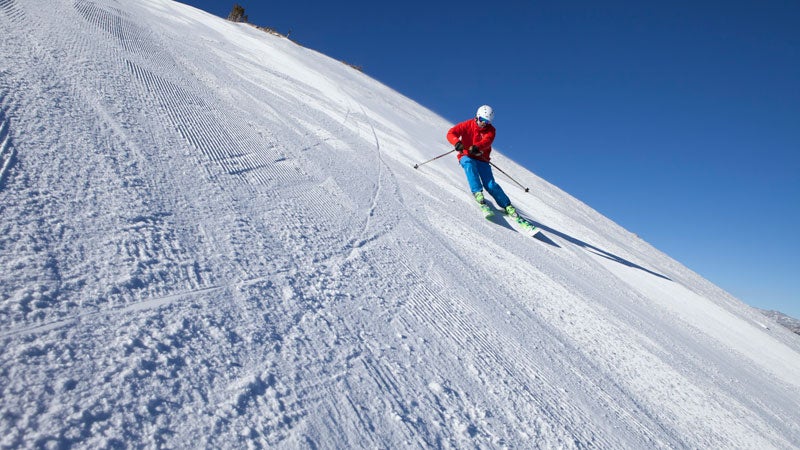
“Groomers are where you first have the feeling on flying,” says Angel Collinson, former racer and big mountain skier. Find the flow and the glow with these tips:
Beginner: Be aware of other people when you’re on a run. Use your peripheral vision—the same skills you use driving. When you’re going to make a turn, check your blindspot to make sure it’s clear for oncoming traffic. Look two turns ahead to make sure your path is clear. Keep a balanced athletic stance. If someone were to throw a football at you should be able to catch it, while staying over your skis, knees slightly bent. Flex your ankles, use your feet to turn your skis.
Intermediate: The best part of groomer skiing is finding a rhythm. Time your turns with your breath, the terrain, a song that’s in your head. Ski a speed that lets you feel in control and comfortable. That speed will dictate your turn shape and flow. Read the terrain, steepness. At the beginning of each turn flex your knees forward and flex your ankles forward pressing into the front of your boot. That engages your ski and will make your ski turn for you. Count to yourself: one two three. One is flexing your ankles, two is carving the apex of your turn, three is a pole plant right before end of turn.
Expert: Carve don’t slarve your turns. When you look back at your tracks you want to see railroad lines in the snow. Ankle flexion is key, and being patient with your turn is key. Angulate your knees and hips to the inside of turn, press your shins into the front of your boot, and drive your knees. Then wait for your skis to come around. Shaped skis are designed to carve. Flex your ankles harder and drive your knees harder to bring your skis around faster. Keep a flow, with the ski bending and releasing. The better your rhythm, the easier your turning will be. You’ll feel like you’re soaring like a bird, or like a dolphin swimming though the ocean. You’re your hands up, which will help you keep your balance. Your upper body stays quiet and upright—you’re not leaning from side to side. Your legs move underneath you doing all the work.


